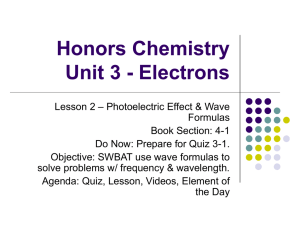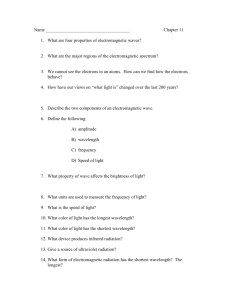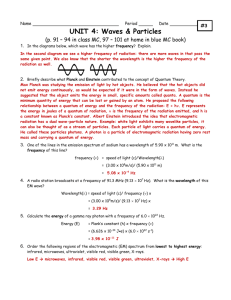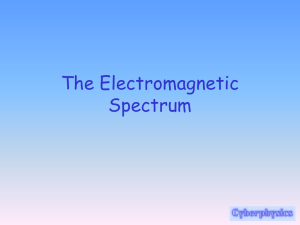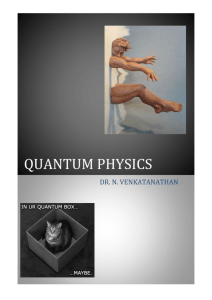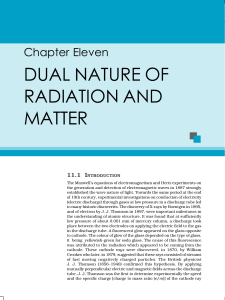Essential Questions
advertisement
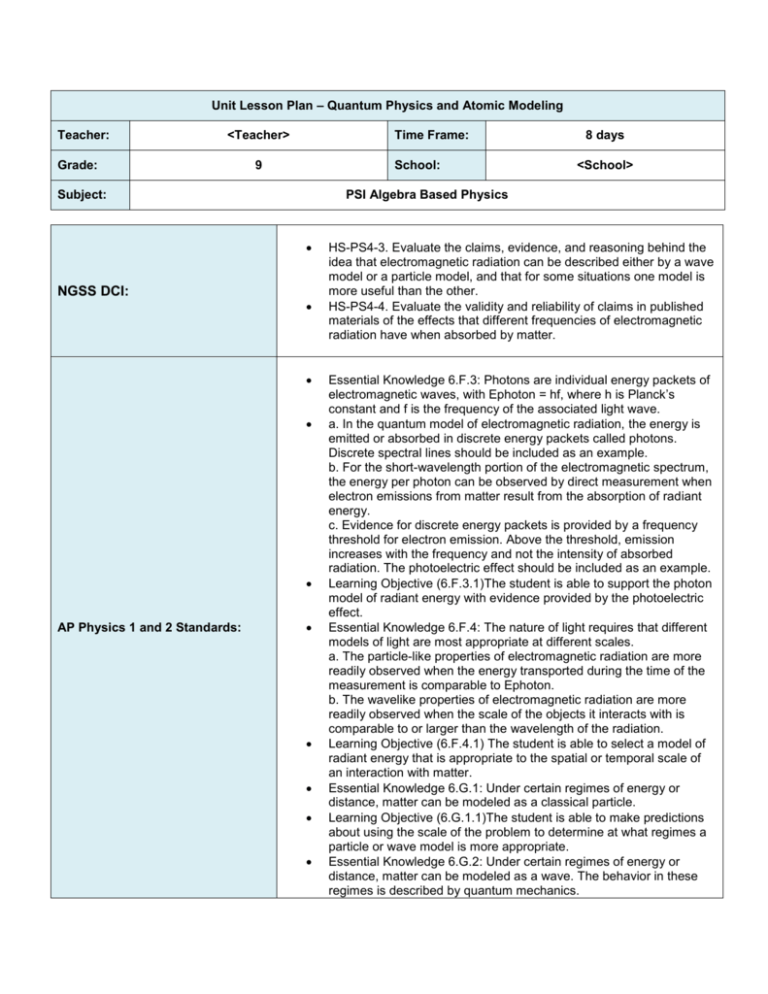
Unit Lesson Plan – Quantum Physics and Atomic Modeling Teacher: <Teacher> Grade: Time Frame: 9 School: Subject: AP Physics 1 and 2 Standards: <School> PSI Algebra Based Physics NGSS DCI: 8 days HS-PS4-3. Evaluate the claims, evidence, and reasoning behind the idea that electromagnetic radiation can be described either by a wave model or a particle model, and that for some situations one model is more useful than the other. HS-PS4-4. Evaluate the validity and reliability of claims in published materials of the effects that different frequencies of electromagnetic radiation have when absorbed by matter. Essential Knowledge 6.F.3: Photons are individual energy packets of electromagnetic waves, with Ephoton = hf, where h is Planck’s constant and f is the frequency of the associated light wave. a. In the quantum model of electromagnetic radiation, the energy is emitted or absorbed in discrete energy packets called photons. Discrete spectral lines should be included as an example. b. For the short-wavelength portion of the electromagnetic spectrum, the energy per photon can be observed by direct measurement when electron emissions from matter result from the absorption of radiant energy. c. Evidence for discrete energy packets is provided by a frequency threshold for electron emission. Above the threshold, emission increases with the frequency and not the intensity of absorbed radiation. The photoelectric effect should be included as an example. Learning Objective (6.F.3.1)The student is able to support the photon model of radiant energy with evidence provided by the photoelectric effect. Essential Knowledge 6.F.4: The nature of light requires that different models of light are most appropriate at different scales. a. The particle-like properties of electromagnetic radiation are more readily observed when the energy transported during the time of the measurement is comparable to Ephoton. b. The wavelike properties of electromagnetic radiation are more readily observed when the scale of the objects it interacts with is comparable to or larger than the wavelength of the radiation. Learning Objective (6.F.4.1) The student is able to select a model of radiant energy that is appropriate to the spatial or temporal scale of an interaction with matter. Essential Knowledge 6.G.1: Under certain regimes of energy or distance, matter can be modeled as a classical particle. Learning Objective (6.G.1.1)The student is able to make predictions about using the scale of the problem to determine at what regimes a particle or wave model is more appropriate. Essential Knowledge 6.G.2: Under certain regimes of energy or distance, matter can be modeled as a wave. The behavior in these regimes is described by quantum mechanics. Note that this exact Smart Notebook presentation has not been used in the classroom, although all of the material has. The pacing below is approximate based on a 40-45 minute class period. Feel free to adjust as necessary and please provide your feedback! a. A wave model of matter is quantified by the de Broglie wavelength that increases as the momentum of the particle decreases. b. The wave property of matter was experimentally confirmed by the diffraction of electrons in the experiments of Clinton Joseph Davisson, Lester Germer, and George Paget Thomson. Learning Objective (6.G.2.1) The student is able to articulate the evidence supporting the claim that a wave model of matter is appropriate to explain the diffraction of matter interacting with a crystal, given conditions where a particle of matter has momentum corresponding to a deBroglie wavelength smaller than the separation between adjacent atoms in the crystal. Learning Objective (6.G.2.2) The student is able to predict the dependence of major features of a diffraction pattern (e.g., spacing between interference maxima), based upon the particle speed and de Broglie wavelength of electrons in an electron beam interacting with a crystal. (de Broglie wavelength need not be given, so students may need to obtain it.) Essential Questions (What questions will the student be able to answer as a result of the instruction?) 1. Who determined the charge on an electron, and what was the name of the experiment? 2. What assumption did Max Planck make to solve the Blackbody radiation problem? 3. What properties of the Photoelectric effect could not be explained by the wave theory of light? 4. How did Albert Einstein explain the Photoelectric effect? Who first postulated that light was made up of particles? 5. Describe the Thomson Plum Pudding model of the atom. 6. What experiment was performed by Ernest Rutherford? How did it change the Thomson model? 7. How did Neils Bohr resolve the problems with the Rutherford model? Knowledge & Skills (What skills are needed to achieve the desired results?) By the end of this unit, students will know: The Oil Drop Experiment Rutherford’s Experiment The Cathode Ray Tube Experiment The Photoelectric Effect The Bohr Model of the Atom By the end of this unit, students will be able to: Solve problems using the following equations: 𝐸 = ℎ𝑓 𝐾𝐸 = 𝑒𝑉0 ℎ𝑓 = ∅ + 𝐾𝐸 𝜆= ℎ 𝑝 Assessment (What is acceptable evidence to show desired results (rubrics, exam, etc.)? Attach Copy During the Smart Notebook lesson designed to introduce concepts, students will be continually questioned on these concepts using a combination of class work/homework questions and the SMART Response system. Classwork and Homework questions will be discussed as a class and misconceptions will be addressed by the teacher prior to the formal evaluations listed below. Quantum Physics and Atomic Modeling Test Other assessments on the NJCTL website are optional and can be used as needed. (What is the sequence of activities, learning experiences, etc, that will lead to desired results (the plan)? Topic Classwork Homework** 1 Electrons, X-rays, & Radioactivity Presentation to slide 77 Problems 1-2 Problems 3-4 2 Blackbody Radiation and the Photoelectric Effect Presentation to slide 118 Problems 5-13 Problems 14-22 3 Atomic Models Presentation to slide 164 Problems 23-24 Problems 25-26 4 Waves and Particles Presentation to slide 178 (the rest is optional) Problems 27-28 Problems 29-30 5 General Problems General Problems # 1, 3, 5 General Problems # 2 & 4 + MC #1-13 6 General Problems General Problem # 6 General Problem # 7 + MC #14-26 (the rest are optional) 7 Review MC Review MC Study for Test 8 Test Quantum Physics and Atomic Modeling Test N/A Day * It may not be possible to complete labs in the order stated due to lab schedules. Other labs on the NJCTL website are option and can be used as needed. www.njctl.org 7th Grade PSI Matter and Energy Flow Note that this exact Smart Notebook presentation has not been used in the classroom, although all of the material has. The pacing below is approximate based on a 40-45 minute class period. Feel free to adjust as necessary and please provide your feedback! **HW Problems are currently not scaffolded from least to most difficult, but are instead listed in order of topic. Teacher should pay special attention at the end of each class period when assigning HW so that only problems related to the topic that was taught are being assigned.

